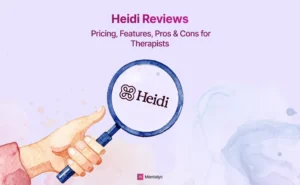Unlocking Minds, Healing Hearts: Delve into the Power of Progress Notes for Individual Therapy – Your Ultimate Guide to Mastering the Art of Note-Taking
In the serene confines of a quaint therapy room, a story unfolds, weaving threads of hope and transformation. Meet Sarah, a resilient soul navigating life’s labyrinthine challenges, seeking solace in the hands of her compassionate therapist, Dr. Salwa. Each week, they embark on a journey of self-discovery and healing, where words blossom like wildflowers, painting the canvas of progress notes. As the ink dances on paper, capturing Sarah’s breakthroughs and setbacks, it becomes a testament to the power of individual therapy and the art of progress notes.
In this article, we delve into therapeutic communication, unveiling tips and techniques to create progress notes for individual therapy, honoring the profound narratives of those seeking guidance on their paths to self-renewal.

Setting the Stage: What Is Psychotherapy?
Psychotherapy, a profoundly dynamic process, unfolds as an exquisite means of liberating the mind from its emotional burdens and navigating personal tribulations through the artful exchange of words. Known as individual psychotherapy, this transformative journey, akin to an engaging dialogue or counseling, blossoms in the harmonious interplay between a discerning client and a skilled mental health professional.

New! Transfer your notes to EHR with a single click. No more copy-pasting.
As the symphony of insight and empathy orchestrates during these compensated sessions, the tapestry of therapeutic outcomes weaves, indelibly influenced by the profundity of the connection between the seeker of solace and their guiding counselor. Eventually, such an experience often marks a turning point in one’s existence – an experience laden with profound transformation and potential for profound self-discovery.
Talking to Friends versus Talking to a Therapist: The Power of a Therapist’s Ear versus the Warmth of a Loved One
In the pursuit of healing and growth, the question arises: should one confide in a therapist or turn to a cherished friend or family member? Undeniably, having someone you trust and feel at ease with in your life is truly invaluable. The connection we share with our loved ones enriches us as human beings. However, embarking on a journey with a therapist offers something unique and transformative beyond the bonds of friendship. Doesn’t it?
- Therapists possess a remarkable skill set that allows them to empathize with your experiences, without being overwhelmed by the emotions that surface. They remain a steady presence, unwavering and non-judgmental, bearing witness to your pain and struggles without rushing to fix or trivialize them. In essence, they embody the epitome of attentive listeners. But it doesn’t stop there.
- Therapists are adept at helping you uncover your blind spots – those elusive patterns in your life that may elude the notice of even the most caring friends. While friends may want to console us by aligning with our perspectives, therapists have the courage to ask the right questions, nudging us to examine our beliefs and behaviors with curiosity rather than judgment. They might even share candid truth bombs, unveiling flaws in our thinking that can lead to profound self-awareness.
- Moreover, therapists have a unique talent for revealing our inner strengths. By genuinely grasping the intricacies of our personal narratives, they identify the underlying qualities that can propel us toward positive transformation.
Of course, it’s essential to recognize that not all therapists and friends hold equal. A genuine and caring friend can often be more valuable than an unsupportive therapist. Both kinds of relationships – the personal and the personal/professional – hold immense value and should be cultivated.

Navigating Professional Guidance versus Personal Empowerment: The Power of Seeking Therapist’s Help versus the Journey to Help Oneself
Sure, there are various ways to work through emotional challenges, like venting at a punching bag, pouring your soul into a journal, or finding solace in yoga classes. Self-help, self-care, and self-improvement undoubtedly contribute to happiness, yet there’s something truly magical about the journey of therapy, fueled by genuine human connection rather than isolated exploration.
Within you lie the answers to many of life’s questions, and a skilled therapist recognizes and respects that. However, books and wellness websites can’t always unlock the depths of your emotions or untangle complex issues. Sometimes, what you truly need is a trusted, insightful guide by your side, leading you to a path of healing and understanding.
Have you ever wondered how individual therapy works, and if it really works at all? The answer lies in the remarkable capacity for change that lies within each of us. Our brains possess a superpower known as neuroplasticity – the ability to adapt and form new connections. This extraordinary feature is what makes individual therapy so effective.
Through the therapeutic process, mental health professionals become catalysts for personal transformation. Research shows that the key to success lies in the strong alliance between the counselor/therapist and the client. This bond fosters a sense of safety and support, making the client feel genuinely heard and understood. Imagine having someone in your corner who not only shares your goals but also has your best interests at heart. Cool, right?
On Writing Progress Notes for Individual Therapy
In the realm of psychotherapy, progress notes serve as the official record of your client’s therapeutic journey. They not only help mental health professionals and insurance companies track your client’s progress but also play a vital role in ensuring the effectiveness of the therapeutic process.
Capturing the essence of your psychotherapy sessions, progress notes are an indispensable component of your practice. Every mental health clinician is obliged to maintain these records as a testament to the significant strides taken by their clients.
Embracing flexibility, you can choose from various formats to document your progress notes. DAP, SOAP, BIRP, GIRP, and PIRP are just a few of the creative templates available to craft your notes.
While there’s no one-size-fits-all approach to progress notes, their impact remains profound. The diversity of state laws and ethical guidelines in the mental health profession means that each clinician must personalize the content of their progress notes.
To craft comprehensive and insightful progress notes, consider including vital elements such as demographics, session details, client symptoms, diagnoses, appearance, mood, safety assessments, treatment modalities employed, interventions, recommendations, client homework, referrals, test results, medical history, functional status, and your signature. Each element weaves a rich tapestry that paints a clear picture of your client’s therapeutic journey.
Mastering the Art of Perfect Progress Notes!
As a therapist, crafting impeccable progress notes becomes an indispensable cornerstone of your career. These skillfully written records serve as the compass that guides your therapeutic journey, enabling you to assess treatment effectiveness and make informed decisions on modifying the treatment plan. Beyond that, they act as a trusted ally, helping you stay on course during therapy sessions, steering clear of irrelevant distractions.
Picture this: A well-structured progress note can elevate your therapeutic practice to new heights, ensuring that the interventions you provide remain etched in memory for the right reasons. With a quick glance, you can effortlessly recollect your client’s ongoing concerns, the tailored treatments employed, and their remarkable progress toward their treatment goals. And let’s not forget the serious implications of neglecting best practices in documenting therapy sessions—professionally, legally, and ethically.
In essence, it’s vital to know how to transform your progress notes into masterpieces: swiftly, efficiently, and up to the highest standards:
Be Professional:
Your progress notes today might find their way into the hands of other healthcare providers whenever your client seeks follow-up care. Avoid excessive abbreviations that could bewilder others. By crafting effective progress notes, you ensure that anyone involved in the patient’s care journey can swiftly grasp their history and previous treatment plans.
Objectivity is the Key:
Write in the third person, steer clear of slang, and resist the urge to express personal feelings about your client’s progress. Maintaining a professional, neutral tone enhances the credibility of your notes.
Solidify Observations with Clear Evidence:
Back up your observations with unequivocal evidence. If you mention a client’s low mood, include concrete markers of their affect, body language, or self-reported condition to enrich the context.
Accuracy matters!
Ensure crucial details such as dates, times, places, and diagnostic codes are meticulously recorded. These seemingly minor elements become crucial signposts when reviewing your notes over time.
Play it Smart! Use Templates!
Streamline your note-taking process with ready-to-use templates. These invaluable tools ensure organization and save time. As you become familiar with them, you can customize templates to suit your preferences. Take your pick from a range of formats like S.O.A.P., B.I.R.P., and D.A.P., selecting the one that seamlessly aligns with your unique needs.
Mentalyc Is by Your Side!
Here’s the good news – you’re never alone on this journey. Embrace the art of note-taking with confidence, for it goes beyond being merely helpful; it is an essential tool for success. And whenever you feel uncertain or in need of a helping hand, always remember that Mentalyc is here to provide the unwavering support and guidance you deserve. You’ve got the resilience within you, and we stand right beside you, cheering you on every step of the way!
References
- Beck, A. T., & Weishaar, M. (1989). Cognitive therapy. In A. Freeman, K. M., Simon, L. E. Beutler, & H. Arkowitz (Eds.), Comprehensive handbook of cognitive therapy (pp. 21-36). New York, NY: Springer.
- Craske, M. G. (2010). Cognitive-behavioral therapy. Washington, DC: American Psychological Association.
- Deci, E. L., & Ryan, R. M. (2012). Self-determination theory. In P. A. M. Van Lange, A. W. Kruglanski, & E. T. Higgins (Eds.), Handbook of theories of social psychology (pp. 416-436). Thousand Oaks, CA: Sage.
- Cain, D. J., Keenan, K., & Rubin, S. (2016). Humanistic psychotherapies: Handbook of research and practice (2nd ed.). Washington, DC: American Psychological Association.
Disclaimer
All examples of mental health documentation are fictional and for informational purposes only.
Why other mental health professionals love Mentalyc

“A lot of my clients love the functionality where I can send them a summary of what we addressed during the session, and they find it very helpful and enlightening.”
Therapist

“By the end of the day, usually by the end of the session, I have my documentation done. I have a thorough, comprehensive note … It’s just saving me hours every week.”
CDCII

“It takes me less than 5 minutes to complete notes … it’s a huge time saver, a huge stress reliever.”
Licensed Marriage and Family Therapist

“Having Mentalyc take away some of the work from me has allowed me to be more present when I’m in session with clients … it took a lot of pressure off.”
LPC






